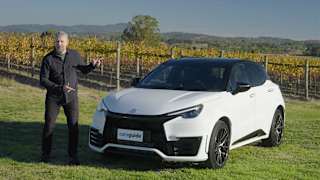The Citroen C5 X is almost as big as a Subaru Outback, and similar in size to a Kia Stinger. So it ought to have a bit of family-friendliness packed in.
Starting at the back, there’s a 545-litre boot capacity, with the kick-action, electronically controlled tailgate that you can also use the keyfob to open. It is a low, wide, quite squared-off aperture, meaning loading bulky items in should be a breeze. Just note that the roofline does taper down towards the rear, so bigger things will need to be pushed towards the seat backrests.
Or, if you’re really acting like a delivery van, you can drop the rear seats down to allow 1640 litres of cargo capacity. There are boot-mounted releases to drop the seats down, and there’s a floor mat in the boot, under which is a space saver spare wheel.
Back seat occupants are decently catered for. I’m 182cm/6’0” tall and I managed to sit behind my own driving position with plenty of leg and foot room - however, the sunroof does create a bit of a hump in the ceiling that you might bump your head on, and those with big feet or small children might want to take note that the sills in the door openings are very tall. A child could easily trip over them if they were clambering in the back in a rush.
Children will be covered with a pair of ISOFIX child-seat anchor points in the window seats and three top-tether restraints, too. There are map pockets, door pockets with bottle holders, a pair of USB-C charge points and directional air vents, too.
However, it wouldn’t be a French car without some kind of quirky cup holder situation, and the back seat has none - there’s no flip-down armrest to speak of. But the seat is exceptionally cushy.
Front seat impressions are good - and cup holders are present. They’re big ones, too - large enough for a big cuppa or a bottle of water, even, And there are door pockets with bottle holsters as well.
There’s an opening centre armrest box with a USB-C charge point, and in front of the interestingly designed recessed gear selector and parking brake, there’s another storage spot with a wireless phone charger, too. Nice.
Seat comfort up front is very good, with lots of adjustability (eight-way electric for the driver, six-way electric for front passenger) and heated front seats as well.
Scoring a big tick from me is the fact there are physical dials and buttons for the air conditioning and ventilation controls. But they’re in that glossy black finish, which shows fingerprints so much that it makes you feel self-conscious of being a walking germ farm.
The big touchscreen multimedia system has a few buttons and knobs, too - though the menus on screen do take some getting used to. It is highly customisable, so if you bought one you’d set it and forget it, but on first impression I struggled to get to grips with some of the nuances of the menus.
It does, however, have wireless or wired Apple CarPlay and Android Auto (with the media-feed USB-C port under the controls) and it goes full screen, too, while leaving enough space for other crucial elements. The graphics are nice and high-definition, and the 360-degree camera display puts the “surround” view units in Peugeot models to shame.
There’s also a configurable driver info screen, and a crisp and lovely head-up display as well.






